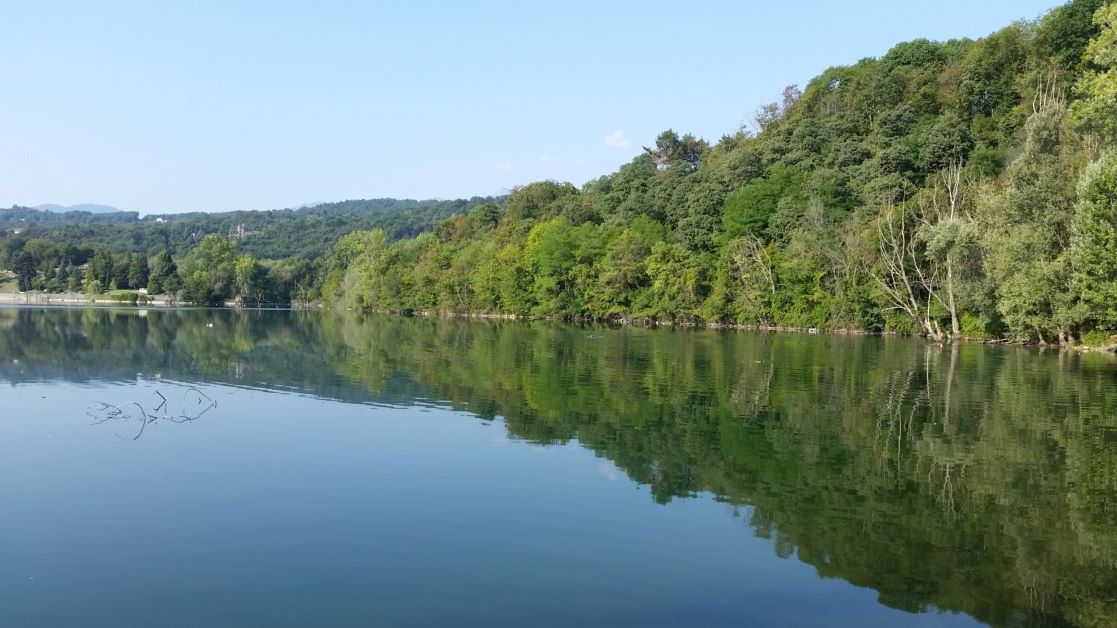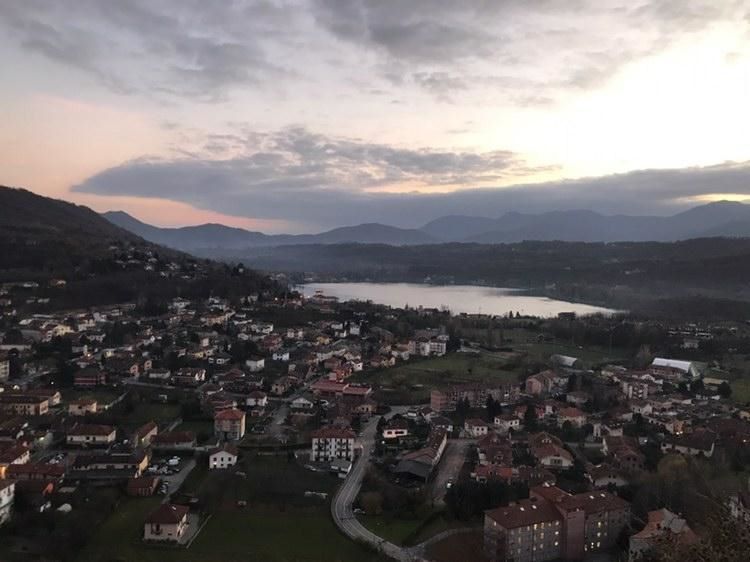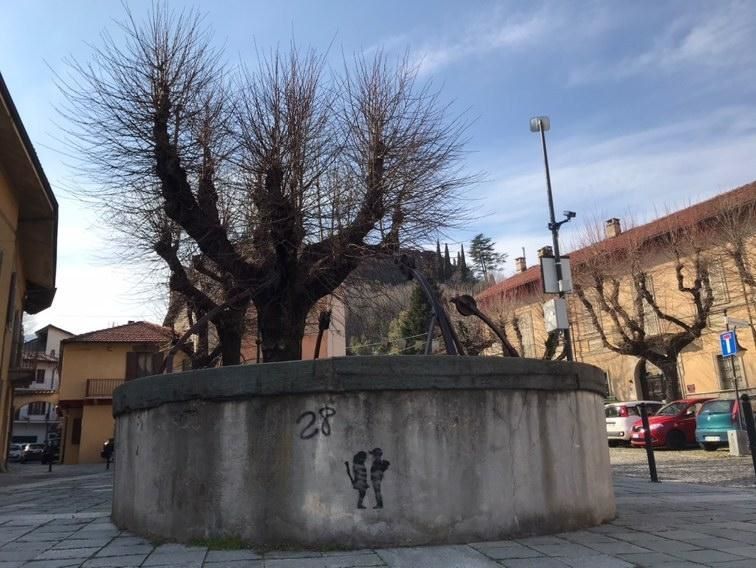This article was enriched by the valuable contributions of Virginia Pellegrin. Photography by Fashion-Vegan-Blogger.
In my last post about the Sacra di San Michele, I promised to discuss the Lakes of Avigliana, as the town and its stunning lakes are an essential stop along the way. So, what can you see and do in Avigliana? Join me as we embark on a delightful stroll through Avigliana and its lakes.
According to legend, Avigliana was once a prosperous village situated where the two lakes stand today. Its inhabitants were known for their wickedness and were tested by God, who appeared as a beggar. He knocked on every door, seeking refreshment, but was turned away and mistreated at every turn. Finally, a poor old woman living in a dilapidated house welcomed him and offered her last piece of bread.
That night, amidst thunder and violent tremors, two gaping chasms opened in the ground, and the village was swallowed by water. By dawn, it was gone, replaced by two large lakes, separated by a small strip of land on which the kind-hearted old woman’s house remained, making her the sole survivor of this divine retribution.
Were you familiar with this legend? Today, we know that the Avigliana lakes are not the product of a fantastical tale, but rather two small lakes formed by moraine during the last significant prehistoric glaciations, created from the accumulation of water among the remnants of the retreated Susa Valley glacier.
Located just 20 km from Turin, the town of Avigliana nestles in the Rivoli-Avigliana morainic amphitheatre, nestled between Mount Pirchiriano—home to the Sacra di San Michele—and the hill of Rivoli. The historic center still echoes its glorious medieval past. We parked our car in Che Guevara Square and were instantly captivated by the captivating view of the ruins of Avigliana Castle, with the Sacra di San Michele rising majestically in the background.
Let’s begin our exploration of medieval remnants! Our journey takes us through the narrow, cobblestoned streets lined with exposed brick walls and low arcades with pointed arches. We truly feel transported back to the Middle Ages! Ahead, we spot a beautifully decorated tower that looks familiar—it’s the Torre dell’Orologio (Clock Tower), an octagonal structure from the late fourteenth century, intriguingly, without a clock!
This tower symbolizes the village’s economic prosperity at the end of the fourteenth century. It is said that near this octagonal tower stood the original Clock Tower, which housed the second public clock ever established in Italy (after the one at Saint Eustorgius in Milan). Perhaps it seems familiar because there is a faithful replica of it in the Borgo Medievale of Turin, specifically in the Cortile di Avigliana (Avigliana Courtyard).
Moreover, the historic residences, Casa Senore and Casa della Porta Ferrata, served as models for the medievalist Alfredo D’Andrade when he created the Casa di Avigliana in the Borgo Medievale (Avigliana House in the Medieval Village). Let’s continue our journey to explore these significant landmarks.
After a few minutes of walking, we arrive at a beautifully detailed façade: the remains of the fourteenth-century Casa di Porta Ferrata. The two Gothic arches and exquisite terracotta decorations, featuring heads of men and animals, fantastical figures, trefoil-mullioned windows, capitals, corbels, and battlements, are truly remarkable.
As we move on, we soon reach the Casa Senore. Similar to the previous house, the façade and portico primarily date back to the fourteenth century. The charm of this building, also known as the Bishop’s House, is highlighted by its herringbone-patterned walls and ornate stone capitals.
Next, we head towards the Castle of Avigliana. The uphill path, surrounded by greenery, leads us to the summit of Mount Pezzulano, where the remnants of the once-mighty castle stand. Built in the 10th century by the Arduinici marquises of Turin, it later came under the Savoy family’s control, who transformed it from a fort into a residence in the fourteenth century. Its destruction occurred during the French raid commanded by General Catinat at the end of the seventeenth century.
After exploring the ruins, look around and enjoy the breathtaking panoramic view of the lakes on one side and the medieval town on the other. The journey to the mountaintop was undoubtedly worthwhile! Now, we retrace our steps down to reach the heart of medieval life: Piazza Conte Rosso (Count Rosso Square). This square is framed by arcades with pointed arches and features an ancient well at its center. The well dates back to the fourteenth century, while the square itself was established around the twelfth century, serving as the hub of medieval commerce and fairs.
This is where we take a break. We relax and recharge because our next adventure leads us to the lakes! We return to the square to fetch the car (especially convenient if you have small children) and head towards the Lago Grande (Great Lake).
After parking and taking a short walk, we arrive at the lake’s edge, where we see visitors enjoying the beach… yes, Lake Avigliana is one of the seven lakes in Piedmont where swimming is permitted. Near the sailing club, a natural swimming area has been created, complete with buoys, ladders, and boulders lining the promenade.

Today, we focus solely on the walk. I’ve always loved the lakeside views, with their diverse colors and lush vegetation framing the water. The sounds of birds, ducks gliding and frolicking, and the leisurely pace create a profoundly relaxing atmosphere for our lakeside stroll!
And so, our refreshing escape from the heat and our day at the Sacra di San Michele concludes here on the shores of Lago Grande, capturing beautiful photos of an unforgettable sunset!
Follow us everywhere!
If you enjoyed this article, please subscribe to our YouTube channel for our video tours. You can also find us on Facebook and Instagram.
Do It Yourself Turin eBook – The Only Travel Guide Written by a Real Tour Guide

An all-in-one guide for exploring freely, complete with maps and suggestions for experiencing the city like a local, including where to eat and what to see.
Do It Yourself TURIN is your trusted Turinese friend, right in your pocket!
Our Most Popular Posts:







